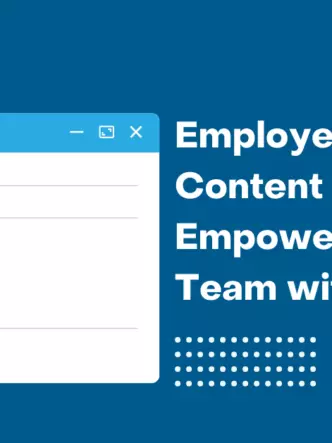Is there a real difference between knowledge sharing and knowledge management?
Businesses rely heavily on a constant, constructive flow of information. They need to know how their own products are selling as well as how they can stay ahead of their competitors. This knowledge can be handled in one of two ways, and there has been a lot of discussion about which is the best way to proceed.
Although there are many companies that still prefer knowledge management, the rise of knowledge sharing has seen a big improvement in how businesses are organized and how they perform.
However, they are not really so different; knowledge sharing is simply an extension of knowledge management and improves on the concepts originally developed. This blog will look at both knowledge management and knowledge sharing and see how your business can benefit from using such approaches.

Part 1: Knowledge management
Knowledge management was viewed as a game changer when it burst onto the corporate scene a few decades ago. It was developed as a way to identify and use collective knowledge in a companies, and to help them sustain a competitive edge over their competitors. 74% of organizations estimate that effective knowledge management increases company productivity by 10-40%.
In general, there are four main aspects to knowledge management:
- Creation
- Storing and retrieving
- Transferring
- Applying
These four parts were then split into smaller groups relating to the creation of internal and external knowledge, and the transferral of knowledge, both internally and externally. For companies that want to benefit from knowledge management, these are the three goals they should aim to achieve:
- Show how knowledge is used within the organization and the role it plays.
- Encourage a culture where knowledge is needed and should be collected and shared.
- Build a knowledge infrastructure to help collaboration.
However, even though the principles of knowledge management are to help companies achieve better results, there is an inherent flaw in this approach; one that renders it as problematic, at least if relied on exclusively:
Knowledge management doesn’t address individual knowledge and doesn’t allow all parts of the business to use it and share it in a productive way.
In fact, for most people within a company, receiving and sharing information and knowledge can be difficult, especially when employees are separated by different time zones, and spread across the globe.
As companies evolve and various departments begin collaborating more frequently with each other, there is a need for a more robust and flexible way to collect and share knowledge.

Part 2: The rise of knowledge sharing
The rise of knowledge sharing culture was to due companies’ need to make knowledge available to everyone within their workforce. In many ways, this is a natural evolution of knowledge management, filling in where the former falls short.
The biggest hurdle to proper knowledge sharing is our trait to keep knowledge to ourselves. In the past, employees greeted the idea of knowledge sharing with a level of skepticism; why impart their unique perspective and insights to fellow employees? Wouldn’t that jeopardize their own position within the company? However, with modern businesses realizing the need to facilitate expert knowledge sharing to fend off competitors, companies often heavily incentivize employees to share their expertise. Workers who are willing to help their colleagues grow professionally are often rewarded, whether in the form of a promotion or other perks. Modern work environments are often unforgiving to those unwilling to collaborate.
One of the most difficult aspects of knowledge sharing is tacit knowledge. The latter is gained from experience and is often difficult to pass on in written form. Trying to write down a skill or task that comes from continuous improvement and experience can often be difficult, if not downright impossible. To add a tacit dimension to your knowledge sharing apparatus will require you and your company to think out of the box.

Part 3: How video can complement knowledge sharing
Video has started to develop into a useful tool for companies looking to perfect knowledge sharing. One of the main reasons for this is that it can often help capture explicit and tacit knowledge in a way that is easy for audiences to consume and comprehend.
Sharing such knowledge is easy if you are using the right tools to capture and share videos. Webcam extensions, often free or very affordable, allow anyone to easily record themselves, their screen or both. This makes it a lot easier for those not used to using video, and no editing experience is required.
It is much, much easier to relay an intricate concept by demonstrating how it’s used in real-time.
Customers and workers will respond much better to video than text-based content.
What would you rather:
A 2000 word manual, or a 3 minute video that gets right to the heart of the issue?
Once the videos are created, there are a couple of intuitive, easy ways to share them throughout the company. Video hosting platforms really prove their weight in gold in this regard. Good ones will offer you a variety of options through which you can upload videos to ensure audiences can binge on them.
It’s important to note that a video approach doesn’t have to supplant a traditional, text-based approach. Rather, it can complement a more traditional knowledge sharing system.

The bottom line
Companies are now under more pressure than ever to outperform their competitors. Knowledge management proved successful at providing companies with a competitive edge, at least for a while.
However, with it incapable of properly addressing individual expertise sharing, a new player emerged.
Knowledge sharing has become an industry go-to, facilitating company cohesion and employee growth. When conducted successfully, knowledge sharing bears considerable fruit. Conversely, companies neglecting it have found themselves regretting doing so.
Easy, intuitive and affordable video solutions can elevate knowledge sharing by providing company experts with the proper tools for sharing tacit knowledge. With team members finding the latter particularly challenging to share, a video solution can truly prove game-changing. Experts can record themselves, their screen or both, and simplify complex concepts; the kind that otherwise would remain siloed, and the exclusive property of a company expert.









